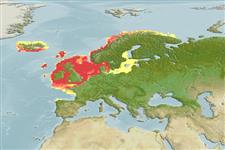Preferred temperature (Ref.
115969): 6.9 - 11.8, mean 8.9 (based on 284 cells).
Phylogenetic diversity index (Ref.
82804): PD
50 = 0.5156 [Uniqueness, from 0.5 = low to 2.0 = high].
Bayesian length-weight: a=0.00776 (0.00688 - 0.00876), b=3.09 (3.05 - 3.13), in cm Total Length, based on LWR estimates for this species (Ref.
93245).
Trophic level (Ref.
69278): 3.0 ±0.0 se; based on diet studies.
Resilience (Ref.
120179): Medium, minimum population doubling time 1.4 - 4.4 years (K=0.3-0.6; tm=2-3; tmax=12; Fec=50,000).
Prior r = 0.72, 95% CL = 0.48 - 1.09, Based on 2 stock assessments.
Fishing Vulnerability (Ref.
59153): Moderate vulnerability (40 of 100).
Climate Vulnerability (Ref.
125649): Moderate vulnerability (43 of 100).
